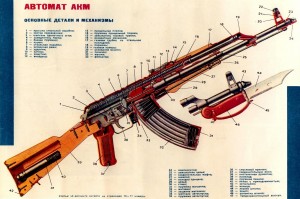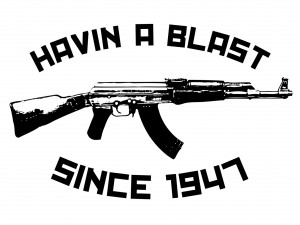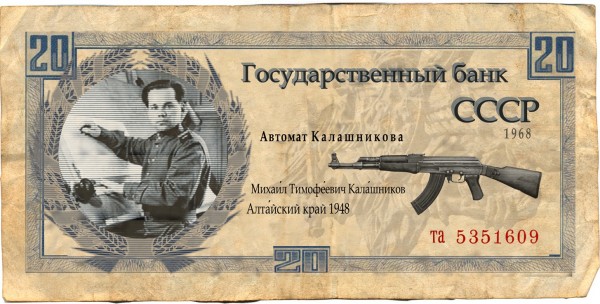WASHINGTON POST: In late September 1941, the German juggernaut reached the outskirts of Bryansk, hard against the Desna River southwest of Moscow. In the battle, the Nazis destroyed about 80 percent of the town and killed more than 80,000 people. Kalashnikov, who was 21, was wounded in his left shoulder when his tank came under artillery fire. He eventually made it to a hospital on foot after a harrowing two-day trip. He suffered nightmares about the Germans slaughtering his comrades. Kalashnikov became obsessed with creating a submachine gun that would drive the Germans from his homeland. In his hospital bed, he sketched out the simplest automatic weapon possible. His obsession would later lead him to a metal shop, where he developed a prototype submachine gun; later to a technical school, where he invented a carbine; and finally, to the creation of the Avtomat Kalashnikova 1947 (AK-47) , approved for production that year. It combined the best characteristics of a submachine gun (light weight and durability) and a machine gun (killing power). By the end of 1949, arms plants had turned out about 80,000 AKs. Although the AK came too late to see action in World War II, the Soviets knew their assault rifle could become the most important weapon of the modern era, and they worked hard to keep it hidden from the West. Soviet soldiers carried their AKs in special pouches that disguised their shape; they picked up spent cartridges to keep the newly sized ammunition a secret. MORE
NEW YORK TIMES: Shorter than traditional infantry rifles and firing a cartridge midway between the power of a pistol and the standard rifle cartridges of the day, the Kalashnikov line was initially dismissed by American  ordnance experts as a weapon of small consequence. It was not particularly accurate or well made, they said, and it lacked range and stopping power. It cemented its place in martial history in the 1960s in Vietnam, where a new American rifle, the M-16, experienced problems with corrosion and jamming in the jungles, while Kalashnikovs, carried by Vietcong guerrillas and North Vietnamese soldiers, worked almost flawlessly. By this time, in an effort to standardize infantry weapons among potential allies, the Soviet Union had exported the rifle’s specifications and its manufacturing technology to China, Egypt, North Korea and Warsaw Pact nations. Communist engineers would eventually share the manufacturing technology with other countries, including Iraq. The weapon’s design was also incorporated into arms manufactured in Finland, Israel, South Africa and other nations. The result was a long line of derivatives and copies. Almost all are referred to as AK-47s by colloquial, if inaccurate, shorthand. Because Kalashnikov rifles were principally made by secretive governments and often changed hands in nontransparent transfers, it is not known how many have been manufactured. Common estimates put production at 70 to 100 million; either number would dwarf the production of any other gun. The rifles eventually filled armories throughout Eastern Europe and Asia and spread from war to war, passing to Soviet allies and proxies, and to terrorists and criminals, aided by intelligence agencies and gray- and black-market sales. The United States became an active purchaser, arming anti-Soviet fighters in Afghanistan in the 1980s and indigenous Afghan and Iraqi forces in recent years. MORE
ordnance experts as a weapon of small consequence. It was not particularly accurate or well made, they said, and it lacked range and stopping power. It cemented its place in martial history in the 1960s in Vietnam, where a new American rifle, the M-16, experienced problems with corrosion and jamming in the jungles, while Kalashnikovs, carried by Vietcong guerrillas and North Vietnamese soldiers, worked almost flawlessly. By this time, in an effort to standardize infantry weapons among potential allies, the Soviet Union had exported the rifle’s specifications and its manufacturing technology to China, Egypt, North Korea and Warsaw Pact nations. Communist engineers would eventually share the manufacturing technology with other countries, including Iraq. The weapon’s design was also incorporated into arms manufactured in Finland, Israel, South Africa and other nations. The result was a long line of derivatives and copies. Almost all are referred to as AK-47s by colloquial, if inaccurate, shorthand. Because Kalashnikov rifles were principally made by secretive governments and often changed hands in nontransparent transfers, it is not known how many have been manufactured. Common estimates put production at 70 to 100 million; either number would dwarf the production of any other gun. The rifles eventually filled armories throughout Eastern Europe and Asia and spread from war to war, passing to Soviet allies and proxies, and to terrorists and criminals, aided by intelligence agencies and gray- and black-market sales. The United States became an active purchaser, arming anti-Soviet fighters in Afghanistan in the 1980s and indigenous Afghan and Iraqi forces in recent years. MORE
RELATED: Since 1998, Osama bin Laden has regularly included an AK-47 in the propaganda videos he releases after terrorist outrages. Consequently, the gun has come to represent the global jihad, and AK-47 is an integral part of the regime at fundamentalist camps, as far apart as the English home counties and the jungles of the Philippines. These groups and their adherents are dedicated to the destruction of Israel and America — yet it is highly likely that it was Israel and America that inadvertently put an AK-47 into bin Laden’s hands. When the Israel Defense Forces invaded Lebanon in 1982 to “crush” the Palestinian Liberation Organization they captured thousands of AK-47s.These guns found their way, via the CIA and the Pakistani Inter-Service Intelligence Agency, to the Mujahadeen resisting the Soviet occupation of Afghanistan. It is probable that amongst them would have been the AK-47 that equips bin Laden. MORE
 YURI ORLOV: Of all the weapons in the vast Soviet arsenal, nothing was more profitable than Avtomat Kalashnikova model of 1947, more commonly known as the AK-47, or Kalashnikov. It’s the world’s most popular assault rifle, a weapon all fighters love. An elegantly simple nine pound amalgamation of forged steel and plywood, it doesn’t break, jam, or overheat. It will shoot whether it’s covered in mud or filled with sand. It’s so easy even a child could use it, and they do. The Soviets put the gun on a coin. Mozambique put it on their flag. Since the end of the Cold War, the Kalashnikov has become the Russian people’s greatest export. After that comes vodka, caviar, suicidal novelists. One thing is for sure, no one was lining up to buy their cars. MORE
YURI ORLOV: Of all the weapons in the vast Soviet arsenal, nothing was more profitable than Avtomat Kalashnikova model of 1947, more commonly known as the AK-47, or Kalashnikov. It’s the world’s most popular assault rifle, a weapon all fighters love. An elegantly simple nine pound amalgamation of forged steel and plywood, it doesn’t break, jam, or overheat. It will shoot whether it’s covered in mud or filled with sand. It’s so easy even a child could use it, and they do. The Soviets put the gun on a coin. Mozambique put it on their flag. Since the end of the Cold War, the Kalashnikov has become the Russian people’s greatest export. After that comes vodka, caviar, suicidal novelists. One thing is for sure, no one was lining up to buy their cars. MORE
JACK VALENTINE: You get rich by giving the poorest people on the planet the means to continue killing each other. Do you know why I do what I do? I mean, there are more prestigous assignments. Keeping track of nuclear arsenals. You’d think that more critical to world security. But, it’s not. No. Nine out of ten war victims today are killed with assault rifles and small arms. Like yours. Those nuclear missiles, they sit in their silos. Your AK-47, that is the real weapon of mass destruction. MORE
ORDELL ROBBIE: AK-47. The very best there is. When you absolutely, positively got to kill every motherfucker in the room, accept no substitutes. MORE

